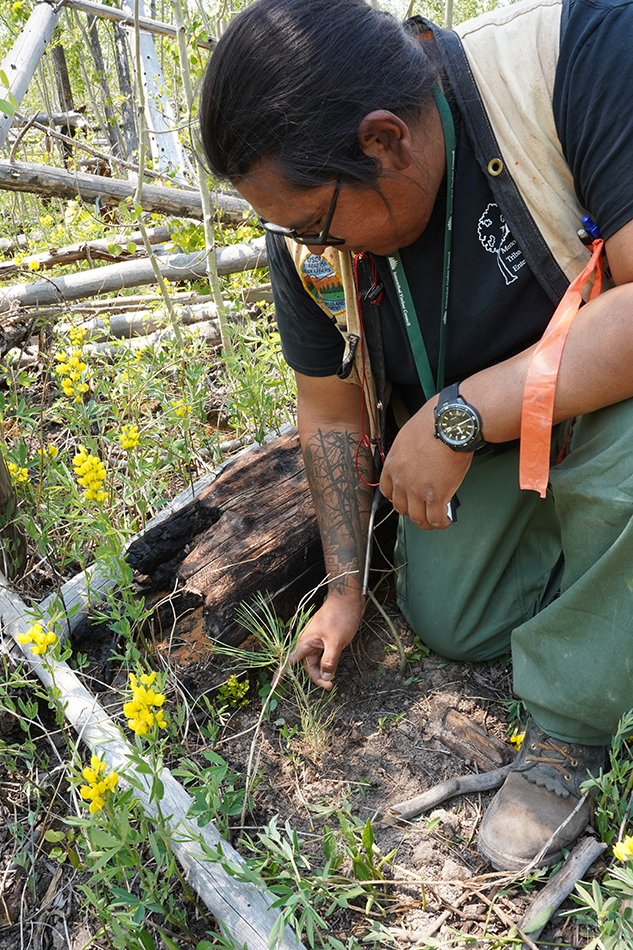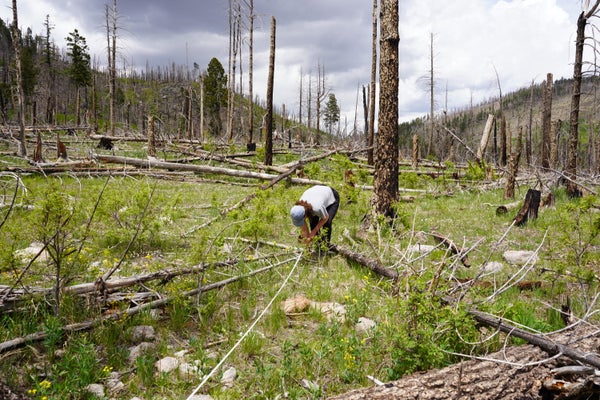When Phillip Tafoya was a young boy in the 1960s, the mountains astride Santa Clara Canyon in northern New Mexico were cloaked in deep green ponderosa pines and Douglas firs. The people of Santa Clara Pueblo, Tafoya’s home, have relied on this forest for cultural uses, food, firewood and recreation for centuries. Today it is mostly gone. Ten years ago the Las Conchas fire—one of the largest in state history—scorched 156,000 acres in the pueblo and surrounding federal lands. The swift-moving flames were so intense in some places that even though these trees had evolved with low-level fires, almost all of them perished.
What remains is a vast tree graveyard. The land is dotted with dead “snags” surrounded by thick mats of crisscrossed fallen logs flanked by fireweed, a purple wildflower that thrives in the open spaces left by blazes. The only living trees are scattered, skinny aspens, which also flourish in this eerily bright and exposed landscape. “This place looks totally different than it did when I was young,” says Tafoya, a project manager for Santa Clara Pueblo, on a hot June day as he sits on one of the thousands of downed logs strewn across the mountainside. “Everything was trees. You could get lost. Now you can see a long ways. There’s no way you could get lost.”
If nature is left to its own devices, most of the aspens will likely eventually give way to shrubs as hotter and drier conditions tax the trees. Without intervention, the forest of Tafoya’s youth may never return.
On supporting science journalism
If you're enjoying this article, consider supporting our award-winning journalism by subscribing. By purchasing a subscription you are helping to ensure the future of impactful stories about the discoveries and ideas shaping our world today.
So he is here in the eastern Jemez Mountains to help do what nature can no longer accomplish on its own. By the end of the day, Tafoya and his small crew will have planted 1,000 pine and fir trees by hand, closing in on a goal of sinking more than 23,000 seedlings in Santa Clara Pueblo lands this year, plus another 24,000 in Santa Fe National Forest and 7,840 in Bandelier National Monument. The project is part of a collaborative effort undertaken by the U. S. Forest Service, the National Park Service, the Nature Conservancy, state universities, area pueblos and others to replant 4,000 acres within the Las Conchas burn scar by the end of 2022. Replanting is crucial not only to resurrect the forest for its own sake but also for creating climate-resilient habitat for the endangered Jemez Mountains salamander, the Mexican spotted owl, Abert’s squirrel and other species. People need this habitat, too: healthy forests prevent erosion and protect water resources for downstream communities, including Santa Clara Pueblo.
This project is one of the first to take advantage of new science on postfire restoration, and it could provide a model for replanting burn sites around the West as climate change fuels larger, hotter fires. “The bigger the fire and the more severe the fire, the less likely the forest will come back on its own,” says New Mexico State Forester Laura McCarthy. But in a climate catch-22, the same conditions driving the need for restoration are making it more difficult. The regeneration program’s scientists, including University of New Mexico forest ecologist Matthew Hurteau and New Mexico State University biologist Owen Burney, have to plan for a far different climate than the one the forest originally evolved in. The Environmental Protection Agency’s climate indicators show average temperatures over the past 20 years in the Southwest were two degrees Fahrenheit warmer than the average over the previous century. The Southwest is the fastest-warming U.S. region after Alaska—and New Mexico is the fastest-warming Southwestern state, according to a 2019 Climate Central report. “We’re planning for a future climate which models are predicting to be warmer and drier,” Burney says. “But even the current conditions for planting are challenging because the fires and climate already make them harsh.”
Transformed by Fire
Fire is a natural and necessary feature of Southwestern forests, clearing out underbrush and keeping the canopy open enough to let light reach the forest floor. Ponderosa pines are built for fire, with thick bark, no lower limbs for flames to climb and deep roots to tap moisture and nutrients below scorched soil. But a century of policy that called for snuffing out fires as soon as they began led to a buildup of skinny trees that have helped fuel larger and hotter wildfires since the mid-1990s. Through decades of research, Craig Allen, a former U.S. Geological Survey forest ecologist, has also found that hotter, drier conditions fueled by the past 20 years of climate change are contributing to mass tree die-offs and more, and more intense, wildfires.
Where burns are severe, the forest is often gone for good: wind alone cannot carry seeds over the vast treeless expanses left behind. A 2018 study by Allen and his colleagues found that during an 18-year drought that lasted through 2013, eight wildfires in New Mexico and Arizona left barren stretches—some the size of 1,900 football fields—that “are unprecedented in the regional historical record,” the researchers wrote. The Forest Service estimated in 2015 that 159,418 acres of ponderosa pine forest in the Southwest were in need of replanting. Other recent studies warn that the region could lose 30 to 50 percent of its traditional forests to severe fires by this century’s end.
Alarmed by the prospect of losing these iconic landscapes, Hurteau, Burney and other Southwest forest experts have spent years devising ways to outsmart climate change and give these forests a fighting chance. The shin-high ponderosa and Douglas fir seedlings each crew member on the Santa Clara replanting team carries in an open-topped backpack were grown in Burney’s lab using seeds gathered from the hardiest specimens of these species in the Jemez Mountains. The seeds were plucked from big, healthy individuals thriving on hot, south-facing slopes or other places where it is already tough to survive. To turn their genetically advantaged offspring into supertrees, Burney conducted greenhouse experiments on the ponderosa seedlings to explore how to toughen them up for the hotter and drier world they will face as they mature.

Forest development and restoration manager Chad Brown examines a newly planted seedling near a downed log in Santa Clara Pueblo in New Mexico. Credit: April Reese
He discovered that if he withheld water until the seedlings almost began to wilt, they developed a clever defense mechanism: they allocated more of the “straws” in their xylem, the tissue that moves water and nutrients up from the roots, to transporting water. This allowed the trees to make the most of what water they did receive. Data collected so far, while incomplete, suggests the average survival for drought-conditioned seedlings in the Jemez Mountains is about 67 percent—a big improvement over the 25 percent survival a 2015 study found for seedlings grown with traditional watering. But other factors, such as browsing by deer and elk, can also affect survival, Burney says.
How the seedlings are planted is just as important as their tolerance for drought. Instead of arranging them in rows, like most timber companies do, the crew plants them in clusters with open ground in between. “The goal is for the tree islands to fill in the gaps between them on their own” by producing seeds that will be carried into the gaps by the wind, says Jens Stevens, who until recently worked on the project as a research ecologist at the USGS’s New Mexico Landscapes Field Station. This technique, called “nucleation,” mimics natural regeneration. It also provides a sort of insurance policy against future blazes: the open areas between the clumps act as natural fire breaks, so even if one patch of trees is destroyed, others are more likely to survive.
Researchers have also learned that planting the trees on a slope confers an advantage, turning them into seed superspreaders. On flatter ground, seeds dropping from cones typically travel up to 100 yards or so from their mother tree, Hurteau says. By falling down a slope, the seeds, aided by the wind, can sprint farther. Planting seedlings in the shadow of logs on north-facing slopes also helps give the new trees a head start, adds Santa Clara Pueblo’s forest development and restoration manager Chad Brown, who chose these sites. “The northwest side gets less sun, so the soil retains more moisture,” he says, touching the earth next to a newly planted seedling.
Long Odds
Even with all of this careful planning, it is unclear how many of the seedlings will survive to maturity. Like most young organisms, trees are at their most vulnerable in their infancy; one fire could easily wipe them out. The same downed logs that shade the seedlings could also fuel a fire that kills them. With experts predicting a dire wildfire season for 2021, that scenario is a real possibility for the trees that Tafoya and his crew have taken such care to plant.
The team may not be able to save every patch of charred forest, but by strategically planting small clusters of trees in as many burn scars as the seed supply, funding and workforce will allow, it can give at least some of the Jemez forests a chance to rise from the ashes, says Stevens, now the Forest Service’s national program lead for wildland fire and fuels research. “That one tree that makes it is going to create another 1,000 trees on its own,” he says. “Just get a few of them to reach maturity and then let them do the work.” Planting is not easy, but all the toil and trouble is well worth it, he adds. “I find planting trees to be really satisfying work,” he says as he checks on seedlings recently planted on a burn scar in Bandelier National Monument. “You’re planting something that might be there long after you’re gone.”
Hurteau has created a computer model, still under peer review, that he says should make future planting projects easier and more successful. Forest managers can use the model—which incorporates data on the local climate, soil moisture, direction that a slope faces and other factors—to determine where seedlings are most likely to survive. He hopes these new tools, and the ongoing lessons learned from the replanting projects, will help improve survival rates and allow land managers across the Southwest to scale up this essential work.
To meet the growing need to replant burn scars in New Mexico, Hurteau, Burney, McCarthy and others are building what they call a statewide “restoration pipeline.” Among the first of its kind in the West, the program will include everything from worker training programs at state colleges and universities to replicating Burney’s forest regeneration nursery in other areas—all crucial steps to meet the overwhelming need to restore burned forests. “The idea is that we’d have a whole soup-to-nuts operation in the state and incorporate lessons learned from these different projects,” Hurteau says.
At the planting site high above Santa Clara Canyon, Tafoya, Brown and the rest of the crew, digital maps in hand, sink more seedlings in the shadow of ghost trees. In one fluid motion, each planter hacks a narrow six-inch hole in the ground with a hoelike tool, pulls a seedling from a backpack, drops it in the hole and sweeps the excavated soil back around the plant, forming a small swale to capture moisture. The whole sequence takes less than two minutes, but the planters are thinking decades ahead. They envision a future where these lands will be a forest again, so that their own offspring can experience the landscape of their youth—remade for a climate-altered future. “It’s gonna take a lot of years,” Tafoya says. “I hope it rains.”
